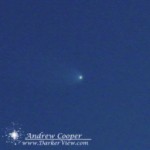The rumor is running around the various astronomy sites and listservers that Comet C/2011 W3 Lovejoy might be daytime visible. Will it be? That is a very qualified maybe.

It becomes a valid question to ask if comet Lovejoy will even survive perihelion transit.
Passing that close to the Sun will mean that the volatile elements of the comet will be streaming off the comet at a fantastic rate, enough to dramatically brighten the comet. Below you will find the ephemeris for perihelion on Dec 16th (Dec 15th HST) from the Minor Planet Center. As you can note, the predicted magnitude is -8! This is bright enough to be seen in broad daylight. Thus the possibility of a daytime comet.
The catch is that the comet will be quite close to the Sun. Within 2° as the Sun and comet rise on the morning of the 15th here in Hawai’i. For observers in the islands the best chance to look is on the morning of the 15th, as perihelion will occur in the afternoon as the comet passed behind the Sun from our point of view.
Will it be visible? Maybe. It depends on the accuracy of the magnitude estimates, which are uncertain to say the least. It could be substantially dimmer, or even substantially brighter than forecast under such conditions. The proximity to the Sun also complicates the issue. It is worth a look, seeing a daytime comet is highly unusual.
If you do look please take a few simple precautions… Do NOT use any sort of optical aid this close to the Sun, the risk of permanent eye damage is too great. If it is bright enough the comet should be a naked eye object. It will greatly help to position yourself to put the Sun just behind some obstruction. A building, a streetlight, anything to block the Sun’s glare and aid in picking out the comet. On the morning of the 15th the comet will rise 2° behind the Sun, thus 2° lower in the sky.
Give it a try!

